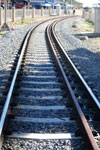

South Africa’s railway system is under the spotlight. The Gautrain is well on its way to completion with all eyes of the world on Africa’s first Rapid Rail Link. And while state-of-the-art technology transforms a dream into reality, other railway sectors still battle theft, vandalism and dated technology.
Transnet Freight Rail (TFR) endlessly tackles cable theft, while Metrorail has been under the hammer with an outburst earlier this year from the Federations of Unions of South Africa (Fedusa), condemning recent accidents where more than 300 passengers were injured. Safety and security are vital to the success of South Africa’s railway system, yet just how effective are the measures that have been put in place to secure this key mode of transport?
August 2009 saw Johannesburg host the Railway Safety and Security Summit with some of the most respected international role players in this industry debating compliance to safety and security regulations and the implementation of more effective management plans in the sector.
It could not have come sooner.
While world class solutions and technologies are being deployed to ensure the Gautrain is of the highest standards in the world, the rest of the country’s extended railway systems are fraught with obstacles. “Investment in sustainable railway infrastructure must be combined with rail safety and security,” says Mpumi Mpofu, director general of the Department of Transport, who, in her keynote address, stressed the need for the rail sector to address power failures, outages, the effect of crime and cable theft on rail accidents, human error and the desperate need to upgrade ageing infrastructure and technology.
“Rolling stock and equipment technologies of most railways in African states fall 20 to 35 years behind today’s proven state-of-the-art operations in developed countries,” she stressed. “And it would be useless developing world-class rail infrastructure if the concerns of railway safety and security were not simultaneously addressed.”

Why the decline?
Paul Cheeseman, global technical director at rail transportation business Stream in the UK, says security issues in the railway sector are multidimensional, all involving loss and cost of some sort:
1. Antisocial behaviour and vandalism.
2. IP espionage/violations.
3. Information systems intrusions.
4. Theft, extortion, fraud.
5. Robberies, assaults.
6. Sabotage of critical infrastructures.
7. Terrorism.
8. Chemical/biological/radiological/nuclear (CBRN) attacks.
9. May be physical or virtual.
10. Arise from existence of threats and vulnerabilities.
11. Not always fully understood and trained for.
12. Mainly characterised by malicious intent.
What are the solutions?
New security measures are usually introduced after attacks, resulting in a reactive solution as opposed to a proactive one. Due to the nature of the walk-on/walk-off railway system, security is difficult to control. Technology such as X-ray screeners, competency tests, people screening, random bag checks and CBRN sensor networks can work but according to Cheeseman, some of these measures (particularly in the South African context) are impractical, not feasible and extremely resource intensive.
TFR makes a plan
Technical security expert, Kay Nayager of Transnet Freight Rail heads up an in-house research and development department for TFR, focusing on security solutions and measures to mitigate the growing security threats hindering the industry. To date he has established three security nerve centres from where all CCTV, access control, tracking systems and alarms are monitored.
According to Kay, the implementation of new technologies to upgrade security is now an ongoing job for TFR. “We are moving away from the past where a guard was used for every security threat. Given our unique security challenges in freight rail, the days of using personnel-based security services are over because they are no longer sufficient for our day-to-day challenges,” he explains. “Our objective is to be less reliant on people and more reliant on remotely managed solutions.”
There are many new public transport facilities being rolled out around the country, but, according to Kay, the security criteria has not been adequately addressed by many organisations. “To my knowledge, security is addressed to minimum requirements,” he states. “This is partly due to the cost of technology which in most cases has to be imported from other countries with best practices. This, coupled with the exchange rate and its financial implications creates a situation where cheap security deterrents compromise ‘the real thing’.”
For TFR, the implementation of high-tech security has served as a strong deterrent. Kay identifies the advantages of electronic access control and the second eye of the CCTV camera. Furthermore, Internet Protocol (IP) and convergence have significantly impacted security levels in the rail industry, as it supports data integrity, he says.
Technology makes a difference
Technology solutions that have really made a difference to the TFR system are the erection of security walls with electronic devices, a Sabre phonic detection system and an electric razor coil alarm system embedded into the walls. The other successful solution has been the implementation of specially designed locking devices, or lock containers.
The security walls have made a difference in two of TFR’s marshalling yards. Simply put, the devices can detect if an intruder is trying to break through or trench under the wall to gain access unlawfully. “The walls were specifically designed to withstand projectiles from an AK47 assault rifle and an R1 rifle. The reason why we chose this option was because the lives of our employees at both yards were threatened on a daily basis. Perpetrators would gain access as there was no proper fencing and would shoot and kill the guards, rob the shunters and drivers as well as pilfer containers on wagons and steal the commodities,” he explains.
Specially designed locking devices, or lock containers have also, over the past three years, added tremendous benefits to customers and the organisation. “Theft out of these containers has decreased drastically, increasing TFR’s integrity and promise to deliver a professional service,” he adds.
The dire effects of cable theft and maintenance
Looking at the long term, Kay believes that TFR’s biggest concern is the lack of specialised companies employed to manage the theft of copper cables. “Research and development implemented on best practice is what is still required,” he argues. “This research should advocate technology that will manage the theft problem to an acceptable level. We have seen a tremendous decrease in other security risks due to the implementation of security technology, so proof that it works is clear.”
All of the above being said, it is narrow minded to think railway security is simply about crime. It is also about ongoing maintenance. However, South Africa’s railway systems are continually challenged. “Preventative maintenance is difficult to carry out due to the ongoing theft of our movable and immovable rail infrastructure; corrective maintenance is largely carried out as a result of criminal activity, consequently affecting the smooth running of all of our rail networks.”
Some food for thought
The Rail Safety Regulator, established with the promulgation of the National Rail Safety Regulator Act in 2002 highlighted the following:
<i.* Poor safety record over the past four years.
* From 04/05–07/08 combined accrued costs for TFR/Metrorail amounted to R2,4b excluding indirect costs.
* Collisions and derailments contributed over 90% of the combined incident costs for both TFR and Metrorail.
* Major contributory factors: human factors; poor state of infrastructure and rolling stock; poor practices and operating procedures.
* Negative perception about rail transport in relation to safety and operational efficiency.
* Investment backlogs eg, PRASA
- Investment backlog = R20b
- Rolling Stock Recap = R60b
- 40% of fleet over 37 years old and one third constantly out of service – reliability and performance poor
- Signalling system at end of economic life – only 23 (14%) of the 162 signalling installations have not exceeded their design life.
- Government (DoT) prioritising increased investment in key areas to stabilise the rail commuter services. There is a need for major investment.
* Loss of critical skills.
* Poor management practices – operating procedures not adhered to.
• Human error.
© Technews Publishing (Pty) Ltd. | All Rights Reserved.